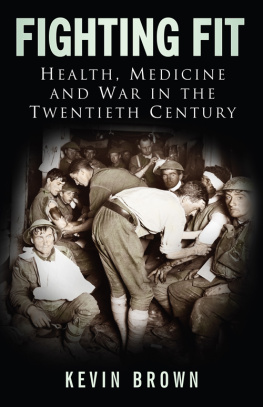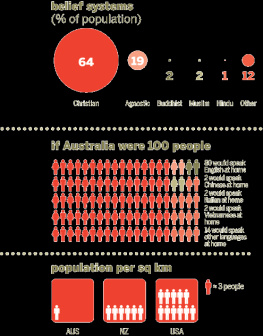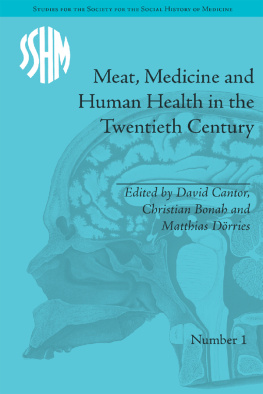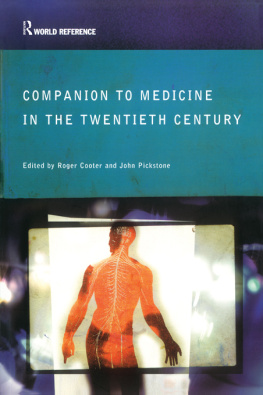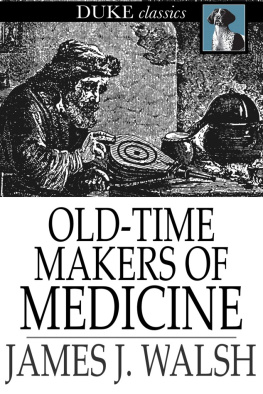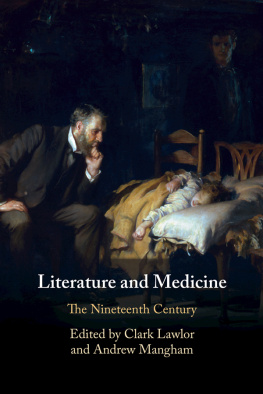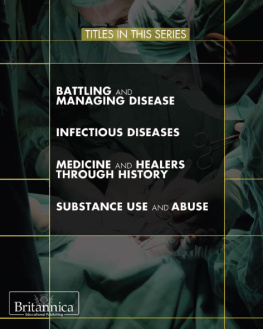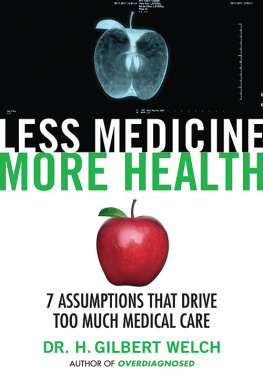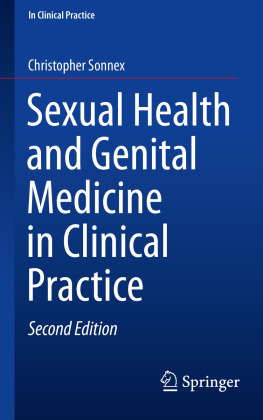Brown - Fighting Fit Health, Medicine and War in the Twentieth Century
Here you can read online Brown - Fighting Fit Health, Medicine and War in the Twentieth Century full text of the book (entire story) in english for free. Download pdf and epub, get meaning, cover and reviews about this ebook. City: Stroud, year: 2012, publisher: The History Press, genre: History. Description of the work, (preface) as well as reviews are available. Best literature library LitArk.com created for fans of good reading and offers a wide selection of genres:
Romance novel
Science fiction
Adventure
Detective
Science
History
Home and family
Prose
Art
Politics
Computer
Non-fiction
Religion
Business
Children
Humor
Choose a favorite category and find really read worthwhile books. Enjoy immersion in the world of imagination, feel the emotions of the characters or learn something new for yourself, make an fascinating discovery.
Fighting Fit Health, Medicine and War in the Twentieth Century: summary, description and annotation
We offer to read an annotation, description, summary or preface (depends on what the author of the book "Fighting Fit Health, Medicine and War in the Twentieth Century" wrote himself). If you haven't found the necessary information about the book — write in the comments, we will try to find it.
Fighting Fit Health, Medicine and War in the Twentieth Century — read online for free the complete book (whole text) full work
Below is the text of the book, divided by pages. System saving the place of the last page read, allows you to conveniently read the book "Fighting Fit Health, Medicine and War in the Twentieth Century" online for free, without having to search again every time where you left off. Put a bookmark, and you can go to the page where you finished reading at any time.
Font size:
Interval:
Bookmark:

In memory of Harry and Ethel Lazenby, Rob and Jennie Brown
When you see millions of the mouthless dead across your dreams in pale battalions go, say not soft things as other men have said, that youll remember. For you need not so.
Charles Hamilton Sorley, 1915.
War and medicine make strange bedfellows. The main purpose of war is to injure, maim and kill. Medicine, by contrast, is dedicated to healing and maintaining good health. Opposing as they may seem, these aims are not totally incompatible. If a nation is to maintain its fighting capability, it requires a healthy citizenry. It also needs to have the means of repairing the ravages inflicted by war on the human body in order to return its servicemen to action as quickly as possible, since, in the words of the great medical humanist Sir William Osler, it is strange that man who dominates Nature has so far departed from Nature as to be the only animal to wage relentless war on his own species. In a modern democracy, a state must be prepared to patch up the damage done to its soldiers by warfare in return for its citizens being ready to risk life and limb; as the Home Front has become as much a battlefield as the theatres of war, medical services for civilian casualties have become part of that implicit pact between state and combatant.
The twentieth century has been marked by wars of great savagery in which technological advances have made the killing machine ever more efficient and deadly. That rapid pace of technological advance in medicine has generally kept pace with the developments in the sinews of war. Indeed in many ways, warfare has accelerated changes in medical practice, though not without opposition from diehard conservative practitioners of military medicine, and has encouraged new ways of looking at things that have been beneficial to patients in general. Both war and medicine in the last century have been impelled by a drive to modernity. War has also unleashed callousness towards injury and has perverted medicine from its nobler ethics, not only under authoritarian regimes but wherever it may be accepted that the ends justify the means. Medicine is not a noble calling above the society in which it operates: it is conditioned by, and an integral part of, that society.
The intimacy in the relationship between health, medicine and war is reflected in the language used to describe medicine. We speak of the battle against infection, we wage war on bacteria and patients fight for life. At the same time metaphors for illness can be used in a military context. Military planners talk of surgical strikes. British serviceman liberating France in 1944 were urged to understand that when anyone has been living for a long time suffering from privation or in a concentration camp, and is suddenly let out, it takes him time to recuperate. And France had developed under the German occupation much of the physical depression of a huge sick-room, and much of the mental stress of a huge concentration camp. Such terminology reinforces the idea of the heroism of medical pioneers and military doctors. It also suggests that in modern warfare, two battles are ongoing simultaneously, the military one of the armed servicemen and the medical one of the doctors, nurses, stretcher-bearers and medical scientists.
This book tells the story of the interrelationship of these two wars over the course of the twentieth century, a subject surprisingly up to now lacking an overview, such as this one, for the whole century. There are tales of heroism and the ideal of the noble warrior, but there are also accounts of the misery caused by warfare and of inhumanity. Yet, there remains in the popular imagination a romantic tinge of heroism attached to the image of the tending of the sick in the heat of battle. Most war films or dramas would be incomplete without a background of ambulances, first aid posts and Red Cross armbands or the heroic figure of the doctor or nurse. Such imagery is often irresistible because so striking. When the opera director Emilio Sagi updated Donizettis La Fille du Rgiment to a Second World War setting for a 2005 production at the Teatro Carlo Felice in Genoa, he had Patrizia Ciofis Marie don a nurses headdress to tend the wounded leg of Juan Diego Flrezs Tonio to make him into a soldier fit to fight and ready for the tenors effortless achievement of his successive nine high Cs. The nurse always remains the beautiful Rose of No Mans Land and the sick and wounded are similarly handsomely idealised. War is never like that and the casualties rarely suffer as picturesquely as in art. Warfare by its very nature is nasty and brutish even when it is justified. Medicine is often very messy.
Yet even out of the chaos and confusion of war can emerge unexpected benefits. It is outside the scope of this book to investigate the ways in which military technology and hardware devised for one purpose subsequently can have entirely pacific benefits in a different context for which they were never envisaged, but we ought to be aware of these possibilities. A classic case of this is ultrasound scanning, which had its origins in a sound-wave device to detect icebergs invented by the American Lewis Nixon in 1906 and subsequently developed to detect the presence of enemy U-boats. By the Second World War, sonograms were being used to detect gallstones, brain tumours, breast cancer and rectal obstructions. Then in the late 1950s the Scottish gynaecologist and obstetrician Ian Donald, a veteran of the First World War, moved on from using ultrasound scanning to detect ovarian cysts to producing clear echoes of babies in the mothers womb to check for foetal abnormalities.
While this book was being written, the newspapers were full of stories of casualties from the fighting in Iraq and Afghanistan, the deplorable closure of specialist military hospitals, the resultant problems in treating wounded service personnel in the general wards and clinics of the National Health Service, and the psychological problems faced by people returning from an unpopular war that their country perhaps should never have got involved in. It seemed as if the pact promising the soldier that he and his dependents would be looked after medically and financially if wounded or killed, in return for risking his life in his countrys service, had been breeched. Sometimes it seems as if nothing has been learned from the experience of the last century. It does give immediacy to the themes running through this book and, as always, the past informs the present and the present helps us towards an understanding of history. Yet, however much there might seem to be similarities, it is as well to remember that society a hundred years ago was different from how it is now. What happened in the past was conditioned by a world that is remote from our own and must be understood in its own setting. Medicine, war and society are interrelated and not separate areas of study: to understand one, we need to know something about all and in the context of the times, not by projecting the concerns of 20078 back to the 1900s. At the same time, it is by looking at the subject over a long period of time that we can better see the development of war and medicine over a century that has known few periods of true peace.
As ever, many people were very helpful while I was researching this book. I am grateful to Bill Frankland, who has relived the ordeal of his experiences as a prisoner of war of the Japanese in Singapore during the Second World War. Michael Wolach has spoken of the absence of any medical aid during his time in a Soviet camp. Barbara Gammon and Betty Ashton have described their experiences of nursing during the Second World War. Andrew Bamji has kindly given me access to the records of Harold Gilliess First World War work on plastic surgery at Queen Marys Hospital Sidcup and has liberally given his time in discussing the subject with me, displaying his great enthusiasm for the topic. At the Queen Victoria Hospital, East Grinstead, Bob Marchant very generously gave me access to the collections of the Queen Victoria Hospital Museum, showed me around the hospital as it is today and pointed out buildings surviving from when Archibald McIndoe was treating burnt airmen there in the 1940s, as well as sharing his memories of working with McIndoe in the post-war years. Nicholas Baldwin, Archivist at Great Ormond Street Childrens Hospital, has supplied references to child welfare during the First World War. From Ellen Reace, I have learned of the experiences of Londoners evacuated to safer areas to have their babies, and their desire to return to the heavily bombed capital during the Second World War. I have happy memories of discussing the First World War influx of female medical students with James Garner when he was doing his history of medicine dissertation on that very topic. Myer Salamon, Richard Keeler, Neil Handley, Bernard Dixon, Maria Lorentzon, Elise Younger, John Grabenstein and Joo Carlos Bolo-Tom, secretary-general of the Fundao Casa de Bragana, have suggested some useful references. Robin Touquet has recommended some leads on more recent military medicine and reminded me of the similarities between military field medicine and the work of modern Accident and Emergency departments. I wish to thank too everyone at The History Press concerned with the commissioning and editing of this, my third book for them.
Next pageFont size:
Interval:
Bookmark:
Similar books «Fighting Fit Health, Medicine and War in the Twentieth Century»
Look at similar books to Fighting Fit Health, Medicine and War in the Twentieth Century. We have selected literature similar in name and meaning in the hope of providing readers with more options to find new, interesting, not yet read works.
Discussion, reviews of the book Fighting Fit Health, Medicine and War in the Twentieth Century and just readers' own opinions. Leave your comments, write what you think about the work, its meaning or the main characters. Specify what exactly you liked and what you didn't like, and why you think so.

